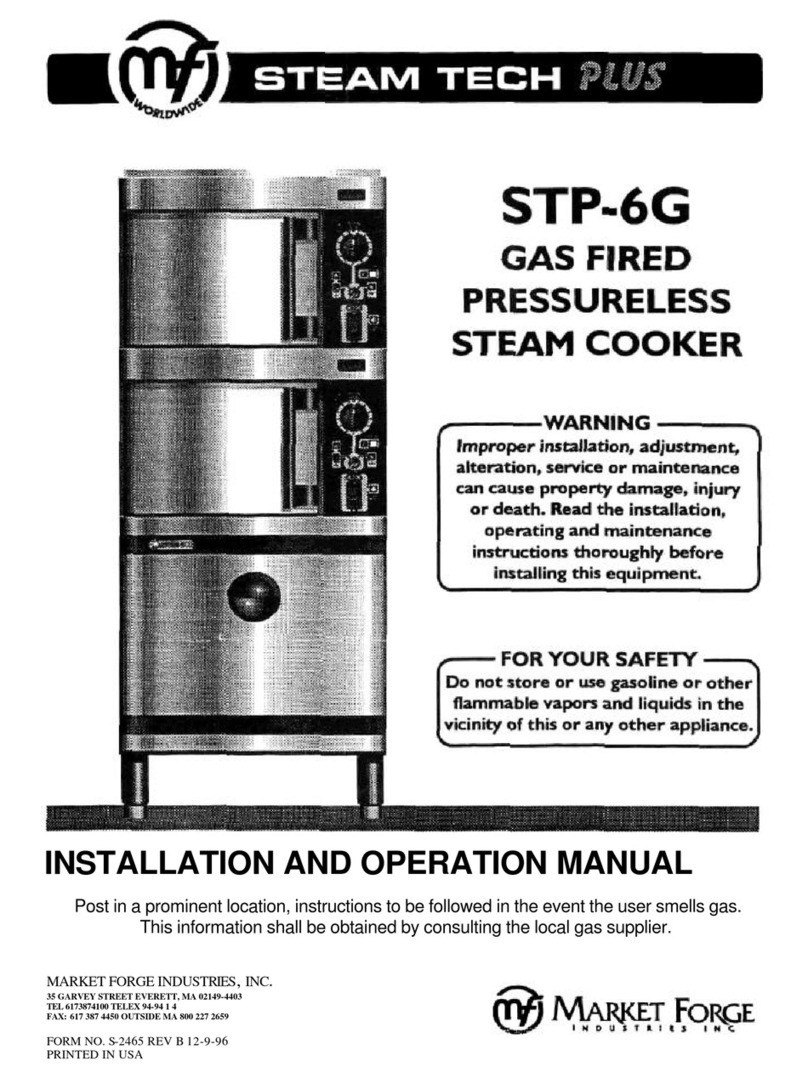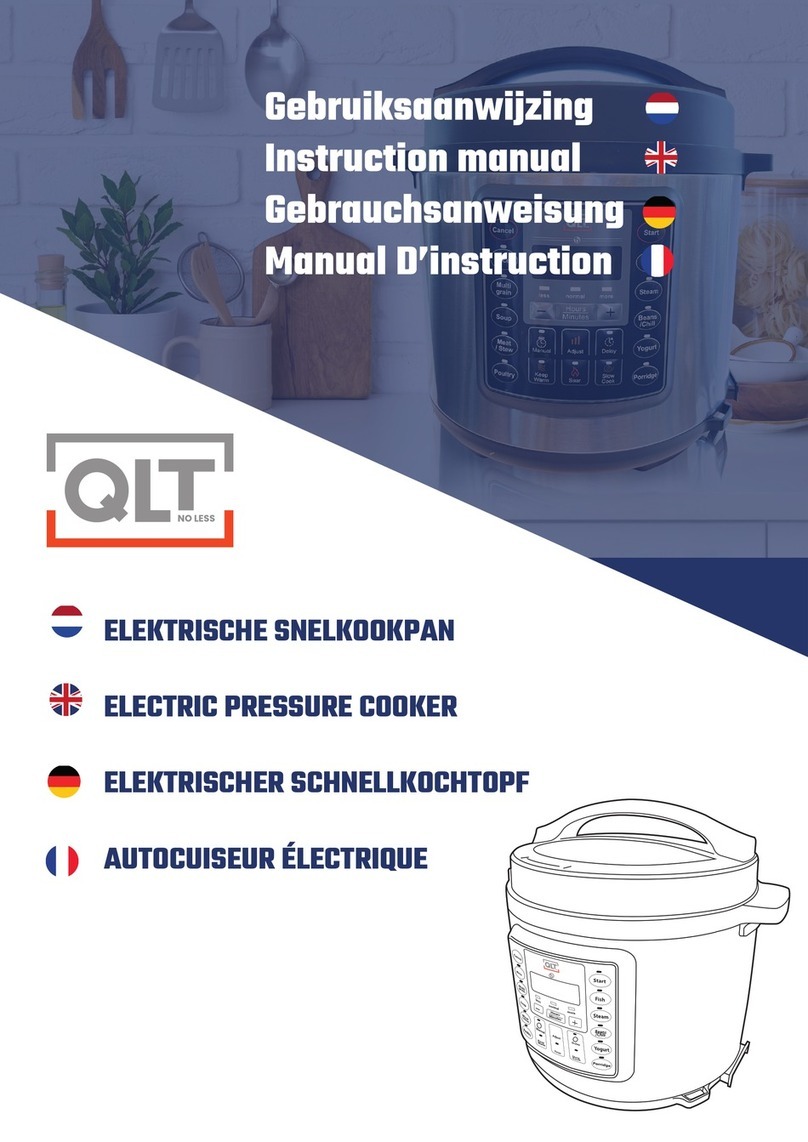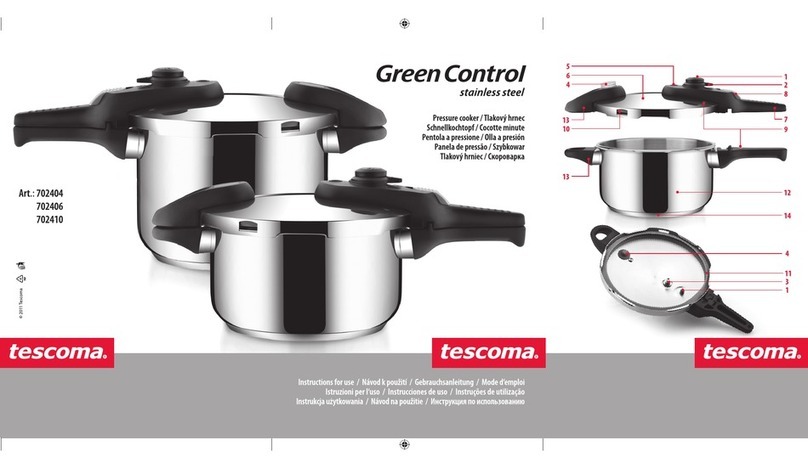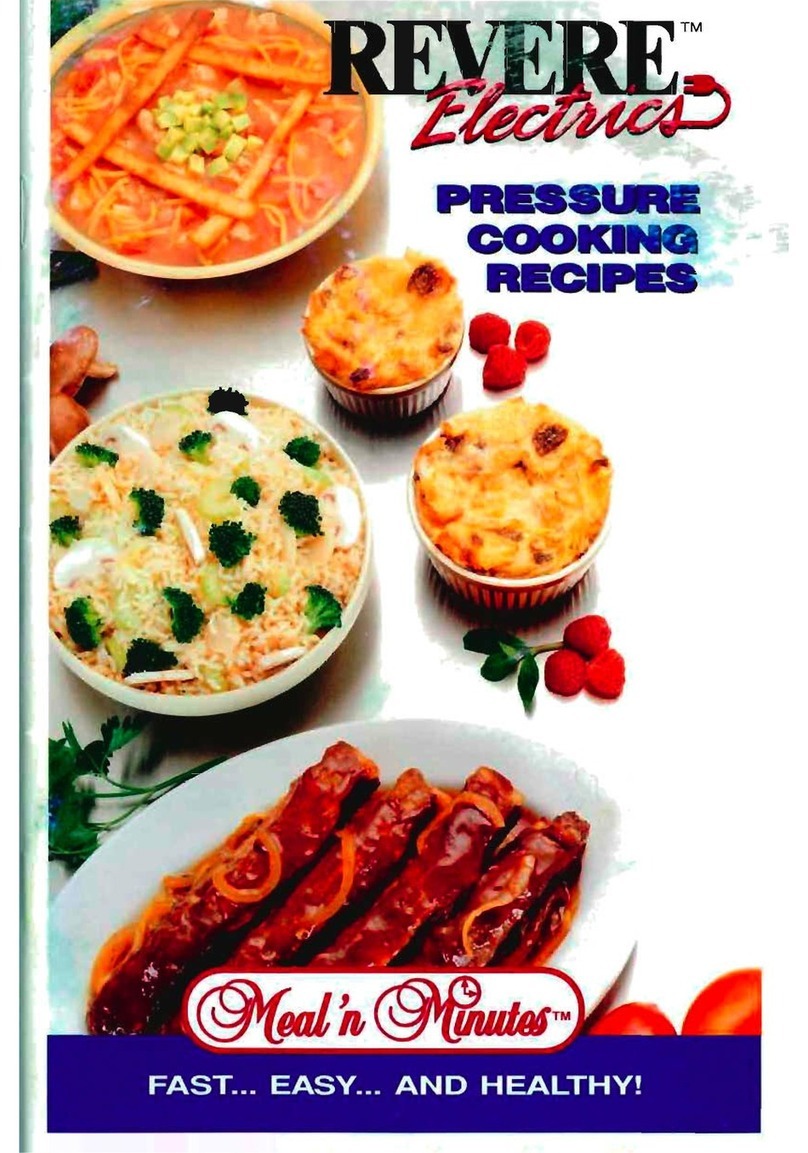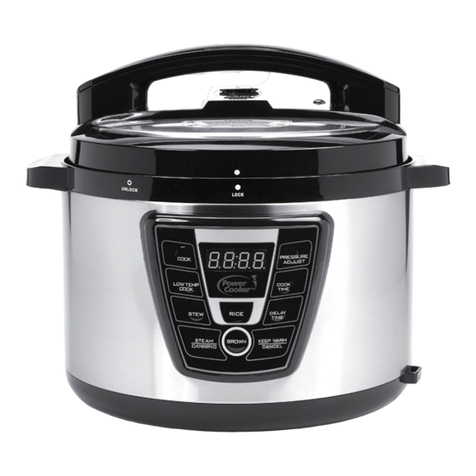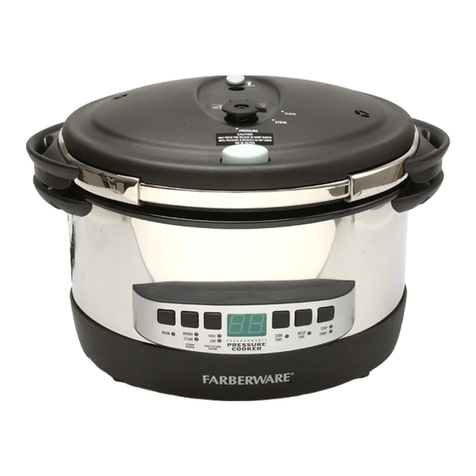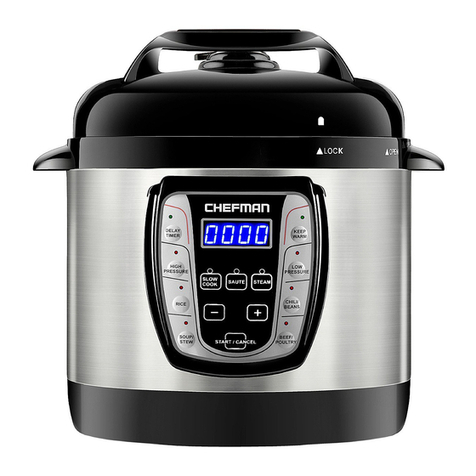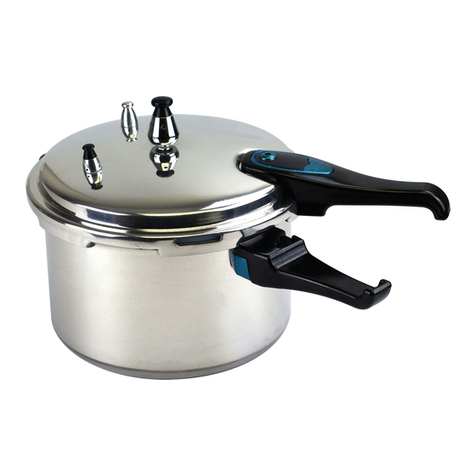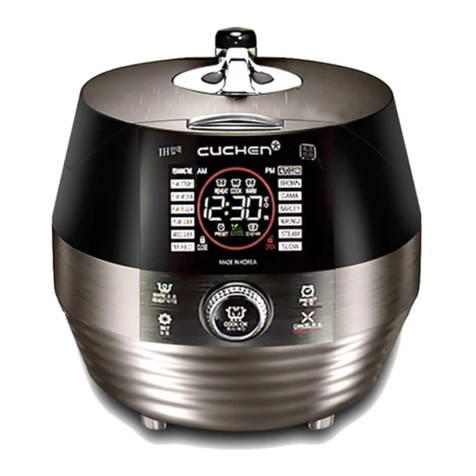Market Forge Industries ST-E STEAM IT User manual

EFFECTIVE SEPTEMBER 14, 2017
ST-E STEAM IT
COUNTERTOP ELECTRIC PRESSURE COOKER
PARTS AND SERVICE MANUAL
MARKET FORGE
Telephone: (802) 658-6600 Fax: (802) 860-3732
www.marketforge.com
P/N 14-0303 Rev C
Superseding All Previous Parts Lists.
The Company reserves the right to make substitution in the event that items specied are not available.
ERRORS: Descriptive and/or typographic errors are subject to correction.

SEPTEMBER 14, 2017 2 ST-E ELECTRIC PRESSURE COOKER
TABLE OF CONTENTS
TROUBLESHOOTING..................................................................3
ADJUSTMENTS & PARTS REPLACEMENT..............................................4
WIRING DIAGRAM................................................................... 10
ILLUSTRATED PARTS LIST
MASTER STEAM-IT ILLUSTRATION .................................................. 15
FULCRUM & DRAIN ASSEMBLY ...................................................... 18
EXHAUST VALVE .................................................................... 20
DOOR HANDLE ASSEMBLY .......................................................... 22
DOOR ASSEMBLY ................................................................... 23
STAND ASSEMBLY - OPTIONAL STEAM-IT STAND .................................... 24
CABINET ASSEMBLY ................................................................ 25

SEPTEMBER 14, 2017 3 ST-E ELECTRIC PRESSURE COOKER
POSSIBLE CAUSE CORRECTION
STEAM-IT FAILS TO OPERATE AT ALL (NO PRESSURE BUILD-UP).
1. Blown fuse.
2. Wiring is defective.
3. Not installed correctly.
4. Element control switch or contactor coil not in circuit.
5. Current not passing through timer to start unit.
1. Replace fuse. If it blows again, check that source of
electric supply is 60 Amps.
2. Check all wiring. Repair or replace.
3. Check wiring diagram for correct hookup.
4. Check both element control switch and contactor coil
for continuity. Repair or replace either if found defective.
5. Check timer for continuity of primary circuit thru timer
control switch.
STEAM-IT OPERATES, BUT FAILS TO BUILD-UP PRESSURE TO 14 LBS. PRESSURE.
1. Steam trap fails to properly close.
2. Exhaust valve fails to hold pressure at 14 lbs.
3. Steam leaks around door.
4. Safety valve blows off below 15 lbs. pressure.
5. Element control switch not properly adjusted.
1. Replace steam trap.
2. Check for correct adjustment or strip down, clean and
repair.
3. Clean seating surfaces and gasket to make sure they
are free of food particles. Check for worn gasket or
make door adjustment.
4. Replace safety valve.
5. Readjust.
UNIT RELEASES PRESSURE BEFORE COOKING CYCLE HAS TERMINATED ON TIMER.
1. Power loss.
2. Low water cut-off has functioned prematurely.
1. Check for disruption at source of electric supply.
2. Adjust or replace low water cut-off.
TIMER DOES NOT FUNCTION AT 10 PSI OF CYLINDER PRESSURE TO START COUNTDOWN.
1. Loose or broken electrical leads to the timer or timer
control switch.
2. Timer motor defective.
3. Timer control switch defective or out of adjustment.
1. Repair or replace defective wiring.
2. Check timer motor for continuity. Replace complete tim-
er if found defective.
3. Make continuity check, adjust, replace if necessary.
UNEVEN COOKING
1. Steam trap closing prematurely preventing removal of
air from the cooking chamber.
1. Replace the steam trap.
HEATING ELEMENTS CUTTING OUT BEFORE 13 LBS. PRESSURE IS REACHED.
1. Pressure cutting off electrical at the element control
switch too soon.
1. Make adjustments on the dial of the element control
switch to remedy.
TROUBLESHOOTING
TROUBLE TESTS & REMEDIES
Timer
If the timer should fail to operate the Steam-It and a check
shows all wiring to be in good order, and should the timer
control switch be found in good order as ascertained by a
continuity check, the timer must be regarded as defective
and must be replaced. The timer is replaceable on as a
complete unit.
Steam Trap
The rst indication of a defective steam trap operation
will usually be evidence by uneven cooking. If working
properly, the steam temperature will be even and cooking
will be uniform through the cooking compartment. Trouble
may occur either through premature closing of the steam
trap before all the cold air has exhausted or by its failure
to close sufciently to enable a proper steam pressure
build-up. Either case warrants the replacement of the
steam trap.

SEPTEMBER 14, 2017 4 ST-E ELECTRIC PRESSURE COOKER
ADJUSTMENTS & PARTS REPLACEMENT
NEW STYLE EXHAUST VALVE (AFTER JULY 1983)
Replacement instructions:
Disconnect tting pressure gauge. Remove ue enclo-
sure. Remove old exhaust by unscrewing 1/4 IPS nipple
from cylinder. Remove safety relief valve assembly from
1/2 IPS nipple. Remove all ttings from the reducing tee
and remove tee and nipple by unscrewing nipple from cyl-
inder, remount nipple and tee in the front 1/4 IPS tap hole.
(Note that the use of the rear 1/4 IPS tap hole is eliminat-
ed, install plug as show on page 26). Mount new exhaust
valve assembly onto 1/2 IPS nipple previously used to
mount safety relief valve (before mounting exhaust valve
assembly, install heat deector plate on valve as shown
on page 26). Reconnect 1/4 OD tubing (steam pressure
line) as shown on page 0. Remount ue enclosure. Install
all new ttings, tubing and wire joints.
NOTE: All parts shown potted are existing to be reused
with new assembly. All items (except ref, items)
and one print of this drawing to be included with
this kit #10 to be used for shipping.
ELEMENT CONTROL SWITCH
The element control switch located under the removable
front lower panel, just left of center, governs the ow os
current to the heating elements to maintain cylinder pres-
sures at a near constant 14 PSI.
A copper tube extending from the top of the cylinder to
the rear position os the element control switch constantly
reects internal cylinder steam pressure upon the built-
in bellows of the elements control switch to cause it to
open or close and electrical circuit to the contactor coil.
With little or no pressure applied to the bellows, the cir-
cuit to the contactor will be closed and providing the timer
is set to cycle, the contactor will click in and current will
ow to the heating elements. When the pressure rises to
14 PSI (original factory setting), the bellows will be suf-
ciently compresses by the steam back-pressure to break
the circuit to the contactor coil, the contactor will click out
and current ow to the heating elements will cease. When
cooling allows the pressure to drop below 13 lbs., the bel-
lows will again complete the contactor coil circuit, activate
the contactor to click in and allow the heating elements
to energize. Thus, by working intermittently to open and
close the contactor coil circuit, the element control switch,
in effect, regulates current ow to the heating elements.

SEPTEMBER 14, 2017 5 ST-E ELECTRIC PRESSURE COOKER
ADJUSTMENTS & PARTS REPLACEMENT
Dial Adjustment
Two dial settings determine the operational range of the
element control switch. The larger dial (D) determines the
maximum build-up of cylinder steam pressure while the
smaller dial (E) governs the range of differential between
the switches cut-in and cut-off points. Should a lower cyl-
inder cooking pressure be desired, adjust the large dial
(D) by inserting a screwdriver onto the slot (B) found at
the center and turning it slightly counterclockwise to lower
the pressure. Clockwise rotation will increase the pres-
sure.
Pressure must not be adjusted to exceed 14 lbs. as the
safety valve is set to automatically open just above this
point. The cut-in and cut-off points of the element control
switch may be adjusted by rotating the small screw at the
center of the smaller dial (E). Normal factory setting is
for a one pound differential between cut-in and cut-off. To
increase the range of differential, rotate the screw coun-
terclockwise.
Check adjustments through a trial cycle by observing
pressure gauge reading when it clicks in after cylinder
cooking. The differential in pressure as read on the pres-
sure gauge should at these points be approximately one
pound.
Recalibrating
The element control switch may be recalibrated should
it vary somewhat through usage from its original factory
setting.
At the precise moment of contactor “clicked-out”, the dial
setting of the element control switch and the steam pres-
sure gauge reading should both be 14 lbs. A slight over-
ride of steam pressure build-up will normally occur and in-
dicate itself on the pressure gauge after the contactor has
“clicked-out”. This is normal and it not to be interpreted as
an element control switch out of calibration.
PRESSURE CONTROL SWITCH
(Formally knows as the element control switch)
NOTE: Models built after September 1980 use 2 Barks-
dale Pressure Switches in place of the White-
Rodgers Element Control Switch and Timer Con-
trol Switch.
Operating Pressure Adjustment
The operating pressure is determined by setting the right
switch (A) at approximately 10 PSI and the left switch (B)
at approximately 14 PSI. Both switches were set At the
factory. These settings can be veried by looking through
the slot (in the red rectangle) and observing the alignment
of the black line inside with the white scales on either side
of the slot. To readjust, turn the white knurled knob in ap-
propriate direction to raise or lower pressure.
WARNING
Because power must be on to adjust pressure
switches, be sure to protect against electri-
cal shock. Check adjustments through a
trial cycle and observe pressure readings on
pressure gauge when switch (B) clicks off at
maximum cylinder pressure and when switch
(A) clicks on after cylinder cooking. Making
adjustments are needed, being careful not to
let switch (B) pressure be set to exceed 14 lbs.
Since the safety valve is set to automatically
open just above this point.
Recalibrating Pressure Control Switch
The actuation valve (differential) is factory set and cannot
be recalibrated.
CLEANING EXHAUST SILENCER
The exhaust silencer should be removed and cleaned pe-
riodically. As the cooking chamber is exhausted of steam
through the silencer, impurities can build up from food
particles. Cleaning should be frequent enough to prevent
clogging to occur. For this reason, the exhaust silencer is
made easily accessible and simple to remove. To clean:
1. Remove the one piece exhaust silencer from the unit
by unscrewing it in a counterclockwise direction.
2. Clean the silencer by sloshing it in hot soapy water
and rinse it in clear water. If dirt has clogged the si-
lencer, presoak it in alkaline cleaning solution.
3. After cleaning, stand the silencer on edge to allow it
to drain.
4. Screw it back into the elbow of the exhaust valve
clockwise.

SEPTEMBER 14, 2017 6 ST-E ELECTRIC PRESSURE COOKER
ADJUSTMENTS & PARTS REPLACEMENT
LOW WATER CUT-OFF
The low water cut-off is mounted above the timer assem-
bly under the front lower panel with its thermostat bulb ex-
tending and inserting into a channel provided for it at the
outer edge of the cast-in heating elements. It functions as
a safety feature to shut off the complete unit in the event
the water runs dry.
If the steam-it operated with no water or the water has
evaporated away, the temperature of the cooking cylinder
will rise and by heat inductions effect the thermostat bulb
of the low water cut-off. Electric current ow will b broken
at the low water cut-off and the unit will shut down. With
the replacement of water into the cooking cylinder, the
thermostat bulb will be cooled and the unit will then again
be operative after the reset button has been pressed.
If the unit does not start after pressing the reset button,
more time will have to be allowed for further cooling.
NOTE: Should a cooking cycle be started with insufcient
water and interrupted due to safety action of the
low water cut-off, the food in the process of cook-
ing will be affected. Proper compensation will
have to be made for the cooking performed and
with proper amount of water in the cooking cylin-
der, a new cycle determined and set to complete
the process.
TIMER CONTROL SWITCH
The timer control switch located under the removable
front lower panel just right of center, automatically delays
the timer count-down at the beginning of the cycle until
the Steam-It has fully free-vented out all the cold air from
within the cooking cylinder and pressure has reached 10
PSI. This delay insures the timer to count only that por-
tion of the cycle when cylinder steam pressure is actually
acting on the foods. This, of course, is important when
processing foods which only require very short periods of
cooking time.
The copper tube which extends from the top of the cyl-
inder to the rear portion of the timer control switch con-
stantly reects internal cylinder steam pressure upon the
timer control switches build-up bellows. While cylinder
free-venting is occurring the switch keeps the timer circuit
open. After free-venting has terminated and when the cyl-
inder pressure has built up to approximately 10 PSI, the
contacts will be forces closed by back-pressures working
on the bellows, the timer circuit will be completes and the
timer will then start its countdown.
Adjustments
The cut-in point of the timer control switch has been facto-
ry set at its maximum setting of 10 lbs., and should not be
altered unless its found that the timer does not start until
well after 10 lbs. of steam pressure has been realized on
the pressure gauge. In this case, insert a screw driver into
the center slot (H) of the larger dial (G) and rotate slightly
counterclockwise to adjust timer to start at 10 PSI.
Recalibrating
Should the timer control switch vary through usage from
its original factory setting, it may be restored to proper
working order by recalibrating. A visual check of the timer
control switch during a trial cycle will quickly determine
the need of recalibration. With the timer control switch dial
set at 10 lbs., (fully clockwise) the timer motor should cut-
in when 10 lbs. of steam pressure is registered on the
steam pressure gauge. By watching the smaller dial (F)
on the timer control switch, the cut-in of the switch may
be observed and heard to click forward at the moment the
circuit is made to the timer motor. At that precise moment
the pressure gauge should read 10 lbs.
1. Set the larger dial (G) of the timer control switch to 10
lbs., (fully clockwise).
2. Loosen the two screws (I) and (J) located on either
side of the dial slot (H).
3. First, note the position of the slot (H) in relation to
4. the dial (G). then while holding the dial stationary, in-
sert a screwdriver into the slot and rotate slightly to
adjust (Clockwise- increase pressure, counterclock-
wise-decrease pressure). Tighten the two screws (I)
and (J) to hold this adjustment.
5. Check the unit through a trial cycle and note the pres-
sure gauge reading when the timer control switch is
observed and heard to click forward. Pressure read-
ing should then be at 10 lbs., (check also may be
made by continuity) readjust if necessary.
SAFETY VALVE
The safety valve is set to automatically relieve the cook-
ing compartment of excessive pressure build-up by open-
ing at a point between 15.5 lbs. and 16 lbs. If the safety
valve should leak continually with a pressure build-up, or
should it cause an interruption of the cooking cycle pre-
maturely (less then 15.5 lbs., on steam gauge) it must be
determined to be defective and be replaced. However, the
steam gauge should rst be checked for accuracy before
making this determination. The steam gauge should reg-
ister absolute zero setting with no pressure in the cooking
cylinder. If the normal zero setting has advanced some-
what through usage (a characteristic of steam gauges)
the amount of advancement from absolute zero must be
subtracted from its registered reading to determine the
true steam pressure.

SEPTEMBER 14, 2017 7 ST-E ELECTRIC PRESSURE COOKER
ADJUSTMENTS & PARTS REPLACEMENT
STEAM TRAP
The steam trap is located with in the ue at the top rear
od the steam-it. It has the very important automatic dual
function of exhausting all cold air from the cooking com-
partment and of making a suitable seal allow a pressure
build-up of live steam during the cooking cycle. Failure of
this unit to operate properly will result in uneven cooking.
FLUE
The ue serves as a protection shield for the steam trap
(B), safety valve (A), exhaust valve (D) as well as a front-
facing mount for the steam gauge (E). As servicing of
these parts may at times require the removal of the ue,
an exploded view drawing is provided to show their prop-
er relative positions within the ue and the method of their
assembly to the cooking cylinder.
Remove the Flue
1. Unscrew and remove exhaust silencer (F).
2. Detach the 3/16” copper tube connector (C) from the
steam gauge (E) at the ferrule nearest the steam
gauge. Then, remove the copper tube entirely by
freeing it at the other ferrule.
3. Apply inward pressure at either sides of the ue at
points (1) and (2) with a screwdriver. This will col-
lapse the side walls slightly to allow the small uted
sections of sheet metal to clear the edges of the ue
opening provided in the outer shell of the steam-it.
With the restrictions of the ue removes, the ue may
then be lifted up over the parts it houses.

SEPTEMBER 14, 2017 8 ST-E ELECTRIC PRESSURE COOKER
ADJUSTMENTS & PARTS REPLACEMENT
DOOR ADJUSTMENT
The door adjustment is located in the fulcrum casting at
the base of the door opening. This adjustment employes
the use of a screw and locknut. To adjust the cooker door
to a tighter closed position (to prevent steam from leaking
by the door gasket as pressure builds-up) its necessary
to loosen the locknut and back off the screw at least one-
quarter of a turn and retighten the locknut.
Figure 1
Remove the Door Assembly
The door assembly can be removed from the inner cook-
ing chamber as a unit without the use of any special tools
or equipment. However, a system attic approach to this is
warranted as the clearances through the portal are close
and much confusion can result if not removed in the se-
quence described below.
1. First, lift off and remove the two pan supports to ex-
pose the door spring from each of the door spring
studs. Accomplish this by counter-acting the force of
the door lift spring with one hand while working the
end of the door spring of the door assembly.
2. When the ends of the door spring have been com-
pletely freed from their respective door spring studs,
the door lift springs on either side of the door assem-
bly can easily be slipped off their studs.
3. When the ends of the door spring have been com-
pletely freed from their respective door spring studs,
the door lift springs on either side of the door assem-
bly can easily be slipped off their studs.
4. Rotate the entire door assembly out through the door
opening, passing the door handle through the open-
ing rst, and then one end of the door spring as shown
in the illustration. The remainder of the door assembly
will then pass through the door opening quite easily.
5. To replace the door assembly, reverse the step by
step procedure backwards.
Door Lift Spring Replacements
Market Forge supplies replacement door lift springs in
sets only. This policy has been found to be in the best
interest of the customer. The loft springs are marked left
and right. They must be installed properly in their marked
left and right positions.
Figure 2
Figure 3

SEPTEMBER 14, 2017 9 ST-E ELECTRIC PRESSURE COOKER
ADJUSTMENTS & PARTS REPLACEMENT
FULCRUM & DRAIN ASSEMBLY
The fulcrum and drain assembly is located at the lower
front of the cooking cylinder and furnishes a sturdy an-
chorage for the door locking system of the door handle.
Also provided in this assembly is a means of adjust for the
door seal. The drain port and drain plug provide a means
of discharging accumulations of water from the cooking
cylinder.
ROLLER ASSEMBLY
Built prior to 10/85 & built after 10/85. The roller assembly
must be kept free-rolling at all times. Should this assem-
bly be allowed to become frozen due to lack of lubrica-
tion, undue strain will be put on the door handle and the
fulcrum casting while the door is being locked. Use only a
dry lubricant such as graphite, as oil or grease will tend to
attract dirt to this area.
COOKER DOOR ASSEMBLY
The door of the cooker has been engineered to establish
a positive method of sealing the steam pressure within
the cooking cylinder. As steam pressure builds up with-
in the cylinder, the door seal will tend to become more
positive. However, the door should be adjusted to make
a good initial seal between the door gasket and the door
opening without the added assistance of internal cylinder
steam pressure. With the simple action of securing the
door handle down in a locked position, the door gasket
should be sufciently compressed against the door open-
ing, all the way around, to prevent any steam leakage
from occurring.
DOOR GASKET
To change the gasket, remove the entire door assembly
as a unit, remove and discard the old gasket, replace
it with a new one (no cement needed) and reinstall the
door assembly. Make an operation check for leaking and
adjust the door if necessary.

SEPTEMBER 14, 2017 10 ST-E ELECTRIC PRESSURE COOKER
WIRING DIAGRAM
COLD WATER CONDENSING UNIT

SEPTEMBER 14, 2017 11 ST-E ELECTRIC PRESSURE COOKER
WIRING DIAGRAM

SEPTEMBER 14, 2017 12 ST-E ELECTRIC PRESSURE COOKER
WIRING DIAGRAM

SEPTEMBER 14, 2017 13 ST-E ELECTRIC PRESSURE COOKER
WIRING DIAGRAM

SEPTEMBER 14, 2017 14 ST-E ELECTRIC PRESSURE COOKER
WIRING DIAGRAM

SEPTEMBER 14, 2017 15 ST-E ELECTRIC PRESSURE COOKER
MASTER STEAM-IT ILLUSTRATION

SEPTEMBER 14, 2017 16 ST-E ELECTRIC PRESSURE COOKER
MASTER STEAM-IT ILLUSTRATION
ITEM PART NO. DESCRIPTION
1 95-3301 Baseplate assy. - xed
2 10-5234 Transformer - 440/480V units
3 * #10 lockwasher, stainless steel
4 * #10-32 x 1/2: binding hd. screw, stainless steel
5 95-3394 Lead assy. transformer
6 10-3095 Plug button
7 95-3289 Plate term strip support
8 95-3484 Cover term box
9 * #8-32 x 1/8” rd. hd. screw, stainless steel
10 10-6969 Ground lug
11 95-3500 Connector
12 10-6967 Reducing washer
13 95-3489 Junction box cover
14 10-6962 Terminal strip section
15 10-6963 Terminal strip end section
16 95-3302 Baseplate sub assy. - moveable
17 10-5466 Contactor 208V, 50/60Hz cycle, complete
- 10-5467 Contactor 230/240V, 50/60Hz cycle, complete
18 10-5470 Coil 208V, 50/60Hz Cycle
- 10-5471 Coil 230V, 50/60Hz Cycle
19 10-5990 Low water cut-off
20 * #6-32 x 1/4” truss hd. screw, stainless steel
21 10-6966 Connector
22 95-0998 Pressure control - open on rise
23 95-0999 Pressure control - close on rise
24 * #10-32 x 1/2” rd. screw, stainless steel
25 10-2904 Adapter - straight 1/4 OD - 1/4 IPSM
26 10-3426 Adapter tee - 1/8 IPS - 1/4 OD - 1/4 ODM
27 10-3652 Reducing bushing 1/4-1/8 IPS
28 95-3305 Tube
29 95-3304 Tube - pressure control
30 10-1154 Union compr. tting 1/4 OD
31 95-3387 Tubing - steam pressure line
32 10-6293 Timer, 60 minute
33 95-3277 Bracket, timer
34 10-6307 Knob, dial
35 95-3403 Bracket, pilot light
36 10-2509 Lockwasher
37 10-2340 Hex nut 10-32
38 10-6669 Pilot light

SEPTEMBER 14, 2017 17 ST-E ELECTRIC PRESSURE COOKER
MASTER STEAM-IT ILLUSTRATION
ITEM PART NO. DESCRIPTION
39 10-4963 Exhaust silencer
40 95-0483 Cage, electric wires
41 10-6964 Conduit nipple
42 10-4110 Speednut #6-32
43 95-0463 Washer
44 * #10-32 x 3/8 hex socket hd. cap screw, stainless steel
45 95-0144 Door handle assy. complete
46 95-0154 Drain plug assy. complete
47 10-0226 Handle bumper
48 * #8-32 x 3/8 binding hd. screw ty. “z”, stainless steel
49 10-4636 Safety valve
50 10-6156 Steam trap
51 10-6158 Adapter
52 - Old style exhaust valve
- 95-0944 Exhaust valve 208V, 60 cycle, complete
- 95-0945 Exhaust valve 230-480V, 60 cycle, complete
- 95-0946 Exhaust valve 230V, 50 cycle, complete
- 95-0946 Exhaust valve 208V & 230V, 50 cycle, complete
52A - New style exhaust valve (Not shown)
- 09-6545 Exhaust valve 220/240V, 50/60 cycle, complete
- 09-6536 Exhaust valve 208V, 50/60 cycle, complete
53 10-3852 Nipple 3/8 IPS
54 10-3851 Elow 3/8 IPS st’d. 90O
55 10-6665 Buzzer, complete
56 95-0115 Fulcrum & drain assy.
57 * 5/16-18 x 11/2” sq. hd. screw, st’l. cap pl.
58 * 5/16 at washer 3/8 ID x #16 ga. st’d. st’l. cap. pl.
59 * Hex nut 5/16-18, st’l. cap pl.
60 10-5036 Connector 3/8 - 90O
61 95-3388 Front lower panel assy.
62 10-6595 Nameplate panel, 60 cycle
63 10-7096 Nameplate panel, 50 cycle
64 95-1466 Rod
65 95-0465 Pan insulation
66 10-1937 Stud
67 95-2545 Pan rack assy. right side
68 95-2546 Pan rack assy. left side
69 * 1/4 shake-proof int. tooth lockwasher, stainless steel
* These parts are available at local hardware, plumbing and electrical outlets. If not obtained, special prices will be quotes by Market
Forge on request.

SEPTEMBER 14, 2017 18 ST-E ELECTRIC PRESSURE COOKER
FULCRUM & DRAIN ASSEMBLY
USED FROM 4/75-10/85
ITEM PART NO. DESCRIPTION
1 95-0116 Fulcrum & drain casting
2 10-3111 1/4-20 x 3/8 helicoil
3 10-2513 1/4” shake-proof washer
4* 10-1790 1/4-20 cap screw, 7/8” long
5 10-2318 10-32 acorn nut
6 10-2514 #10 shake-proof lockwasher
7 95-0198 Bronze bearing
8 95-0120 Bearing spacer
9 10-1999 10-32 machine screw 1.5” long
10 95-0149 Roller assy. (#5 thru 9)
ITEM PART NO. DESCRIPTION
11* 10-1763 1/4-20 machine screw, 3/4” long
12 10-2087 1/4-20 allen set screw
13 10-2353 1/4-20 jam nut
14 10-3116 1/4-20 x 5/8 helicoil
-- 95-0115
Complete fulcrum assy.
(#1 thru 14)
15 95-0658 Drain plug handle
16 10-2227 Drain plug
17 10-2359 1/4-20 acorn nut
18 95-2604 Drain & plug handle assy. (complete)
* Obtain at local hardware store.

SEPTEMBER 14, 2017 19 ST-E ELECTRIC PRESSURE COOKER
FULCRUM & DRAIN ASSEMBLY
FOR UNITS BUILT AFTER 10/85
ITEM PART NO. DESCRIPTION
1 10-3116 1/4-20 x 5/8 helicoil
2 10-1999 10-32 machine screw, 1 5/8” long
3 10-2358 1/4-20 fulcrum nut
4 10-0287 1/4-20 allen set screw
5 10-3111 1/4-20 x 3/8 helicoil
6 10-2513 1/4” shake-proof washer
7* 10-1763 1/4-20 machine screw, 3/4” long
8 95-0120 Bearing spacer
9 95-0198 Bronze bearing
ITEM PART NO. DESCRIPTION
10 10-3111 1/4-20 x 3/8 helicoil
11 10-2513 1/4” shake-proof washer
12* 10-1790 1/4-20 cap screw, 7/8” long
13 10-2514 #10 shake-proof lockwasher
14 10-2318 10-32 acorn nut
15 95-3850 Fulcrum & drain casting
16 10-1041 Ball valve
-- 95-3992 Fulcrum & drain assy.
(#1 thru 15)
* Obtain at local hardware store.

SEPTEMBER 14, 2017 20 ST-E ELECTRIC PRESSURE COOKER
EXHAUST VALVE
BUILT PRIOR TO JULY 1983
ITEM PART NO. DESCRIPTION
1 95-0756 Tee assy.
2 95-0372 Ball & pin assy.
3 95-2077 Diaphragm body assy.
4 10-2425 #10 at washer 3/16” ID x 1/2 OD x .086
(cad. pl)
5 10-4675 Spring compression
6 10-1663 Pin, cotter 1/16 x 1/2” stainless steel
7 95-0431 Solenoid bracket assy.
8 10-1759 #10 10-32 x 3/8” rd. hd. screw (cad. pl)
9 10-2505 #10 lockwasher (cad. pl)
10 10-1701 1/4-20 x 3/8” rd. hd. screw (cad. pl)
11 10-2500 1/4 lockwasher (cad. pl)
12 95-0755 Channel
13 10-1678 Pin, roll 1/8 x 1-1/8” (cad. pl)
14 95-0760 Pin, solenoid
ITEM PART NO. DESCRIPTION
15 10-6663 Coil - 208V, 60 cycle
10-6664 Coil - 208V, 50 cycle
10-6656 Coil - 230V, 60 cycle
10-6657 Coil - 230V, 50 cycle
16 10-6662 Solenoid - 208V, 60 cycle, complete
10-6667 Solenoid - 208V, 50 cycle, complete
10-6655 Solenoid - 230V, 60 cycle, complete
10-6660 Solenoid - 230V, 50 cycle, complete
- 95-0944 Exhaust valve, 208V, 60 cyle, complete
95-0947 Exhaust valve, 208V, 50 cyle, complete
95-0945 Exhaust valve, 208-480V, 60 cyle, com-
plete
95-0946 Exhaust valve, 230V, 50 cyle, complete
- 95-3197 Assy. (#1 thru 6) complete
Table of contents
Other Market Forge Industries Electric Pressure Cooker manuals
Popular Electric Pressure Cooker manuals by other brands
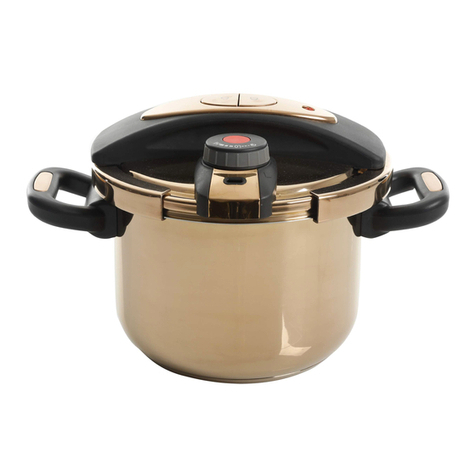
Kenmore
Kenmore 126399 Use & care guide

Cook's essentials
Cook's essentials EPC460 instruction manual
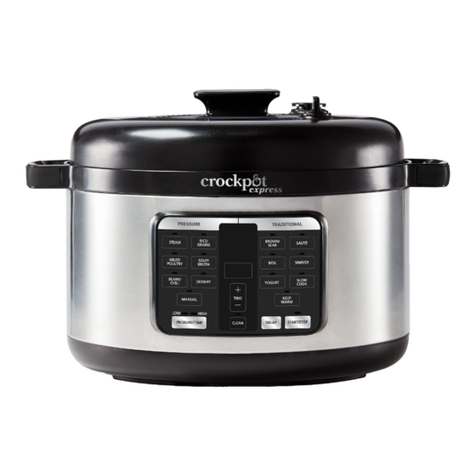
Crock-Pot
Crock-Pot Express 6Qt Oval Max owner's manual
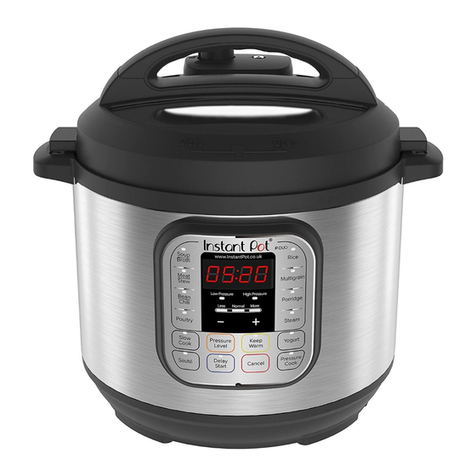
InstantPot
InstantPot Duo quick start guide
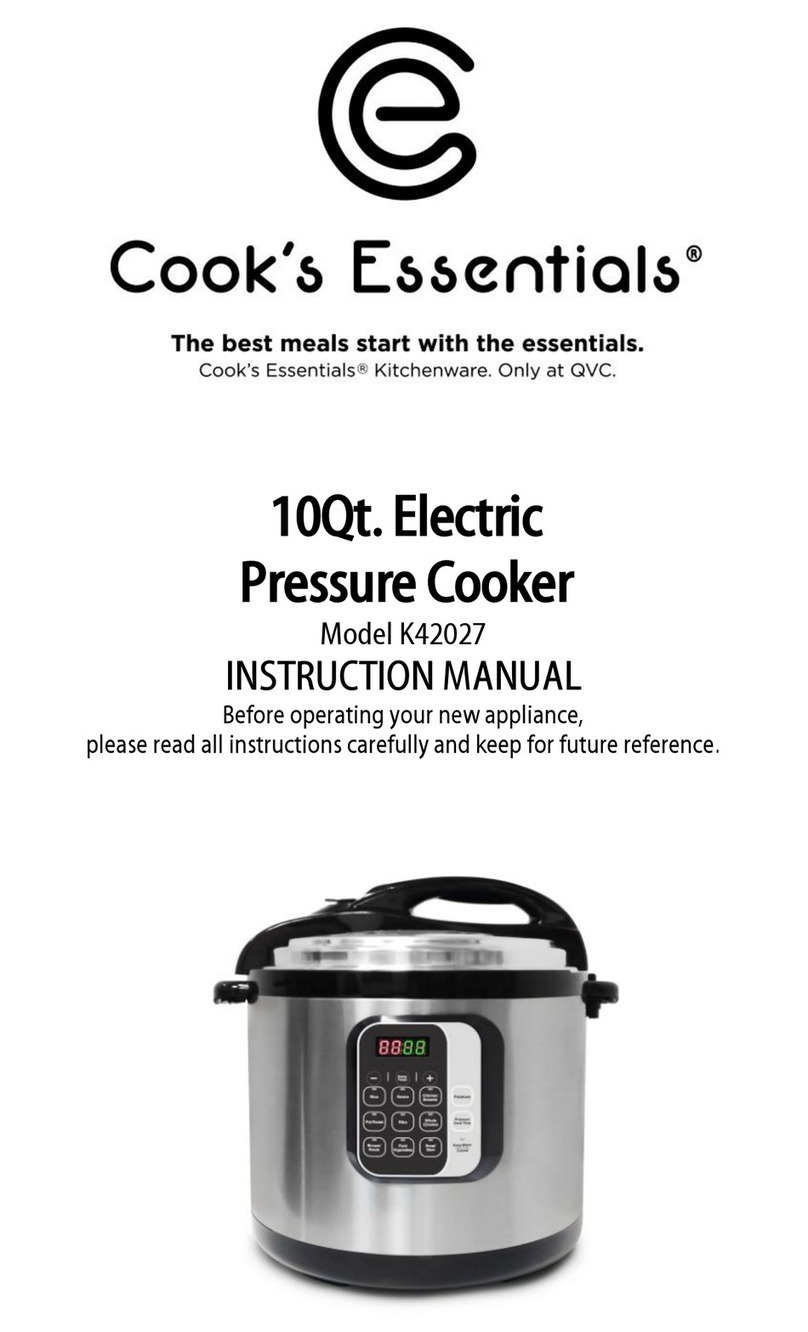
Cook's essentials
Cook's essentials K42027 instruction manual
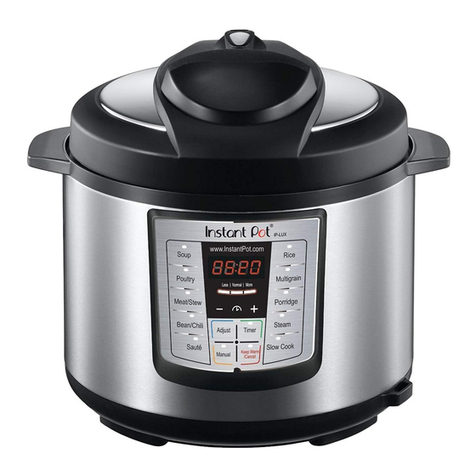
InstantPot
InstantPot IP-LUX60 Quick reference guide
